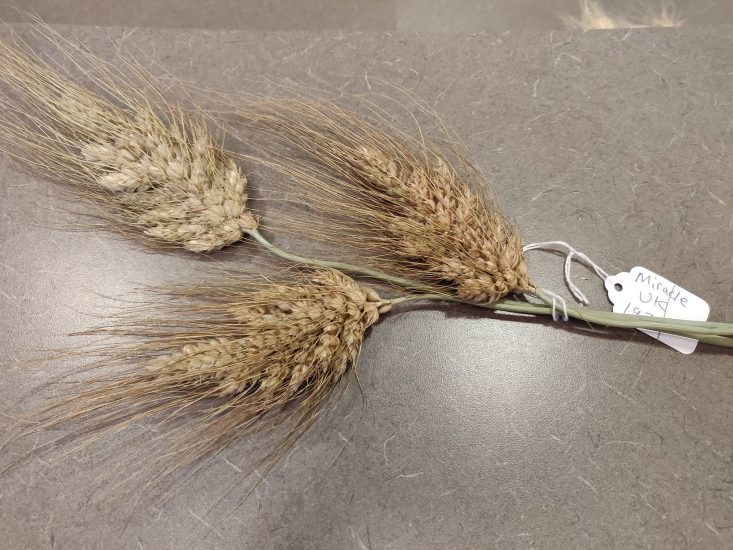
We need to talk about… Grain
At our February 2022 Kitchen Table, Going with the Grain, Trustee Naomi Duguid hosted a discussion between baker and grain activist Dawn Woodward; UK farmer Fred Price who grows grain, keeps pigs and runs a bakery on the farm; and seed-scientist Prof. Kevin Murphy of Washington State University. What follows is an edited digest of the very engaged chatline.
ON FARMING:
[In the US] we have great farmers like Heinz Thomet of Next Step Produce and bakers like Jonathan Betony of SeylouBakery in my hometown of Washington, DC and the surrounding area that are doing wonderful work with sorghum, buckwheat, rye, millet, barley, oats, etc. Next Step Produce has been serving as a central processing facility for other farmers in the area growing these grains. They are a huge force for change in the region.
It’s important to register that havinglivestock makes farming a lot easier. Let’s hear it for the native bees and wild pollinators diversifying the landscape. If buckwheat is bee-friendly, sounds like a good reason to grow it.
[Pigs are a logical add-on for a traditional grain-farmer]. We have a ready market for our pork, but we don’t sell at a premium. Pork-lard [available because traditional breeds have plenty of fat] is very good for light shortcrust and hot-water pastry [for raised pies], and very traditional.
ON EXPERIMENTATION
Interesting to experiment with grains, like teff for injera – maybe making a sweet version of injera, or use in desserts. Both teff & buckwheat are GF (gluten-free), so cross-contamination could be a problem. [Note: Eragrostis tef is a member of the millet/spinach family endemic to Ethiopia and Eritrea, now in cultivation in the US and Canada.]
As a micro-bakery in a small city in West Yorkshire, I find it challenging to captivate my market to the kind of product I want to be making. Wholegrain, varied flours, are still the choice of a minority of customers. Added to that that baking with these type of grains, properly grown and well sourced, makes the end product a lot more expensive.
Ideally, should we sprout the grains or naturally ferment the flour anytime we are using unsifted flour in order to reduce phytic acids? [Phytic acid is a natural substance found in plant seeds that impairs the absorption of iron, zinc and calcium so can lead to mineral deficiencies].
Grain-dough fermentation does more good than just degrading phytic acid, but it for sure does that, and more effectively than does sprouting. Removing the outer bran layer without the aleurone is very difficult. And if you remove the true bran the aleurone is replete with phytic acid.
Buckwheat pasta has an exquisite flavor, but I know from cooking for friends affected by celiac how hard it is to find 100% buckwheat products.
ON BAKING
My job as a baker is to be part of the food chain. Shared responsibility strengthens the food-producing community. [As a baker] I love rye amd buckwheat! So interesting to work with.
Excited to learn about Sangaste Rye. We plan to plant rye and malt it on our farm. But my (limited) research on rye cultivars has not yielded many varieties. Most of the time rye is sold as a cover crop and not a cash crop and there’s little attention to variety. I’m based in inland Pacific North West, so perhaps it’s a regional issue.
I find spelt really intro-level friendly when baking bread. As a beginner at sourdough I have quite quickly evolved to 320g wholemeal spelt and 200g strong white as I couldn’t face making white bread.
I see a movement towards 100% unsifted flour in bread but I find it difficult to bake and teach recipes with 100% unsiftedflour: [seems there are] skills and techniques at the very basic level I need to add to my teaching.
As a culinary instructor and chef, I have the same question, but regarding pasta-making. I am more interested in pasta made with buckwheat, rye, barley, etc., for all sorts of reasons, but its nearly impossible to use 100% of these flours in doughs – always need a bit of 00 or all-purpose. At least for breads, with me there is no compromise, I just start with 100% whole flour and don’t ever let the learners even have sifted flour to compare with.
[On the other hand] perhaps we’re a little to obsessed with loaves of bread, when we could be talking about, for example, buckwheat galettes or other flatbreads. Pitas are super easy to make with whole flours, a really forgiving bread style.
There’s a tradition among German home-bakers for home-milling so the flour is fresh. I have made a good Irish soda bread with unsifted flour from an organic farm in the UK and the flour kept well for over a year. There’s a lot of fat in grain, so as soon you open it up, the fresher the better. Such a flip from thinking about bread as the vehicle for flavour, to bread as the flavour itself.
THE LAST WORD: Where margins of financial gain are small, we’d better do something we love, believe in and enjoy.
